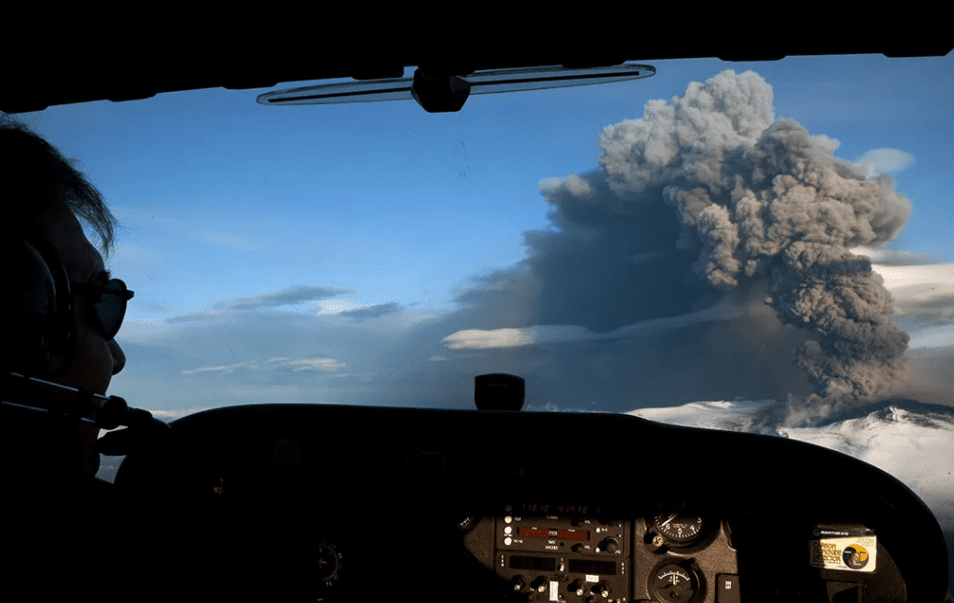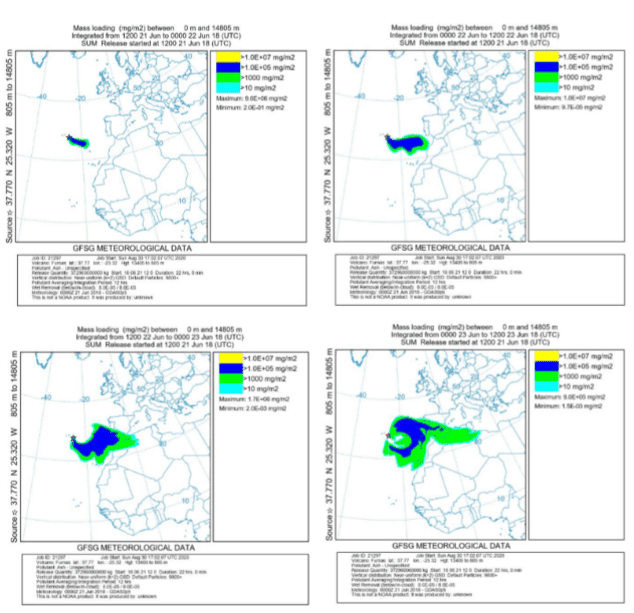O OVGA é um Centro de Ciência que desenvolve atividade de investigação aplicada e de divulgação científica na área da Vulcanologia, da Sismologia e da Geotermia.
Notícia -A A +A
Understanding future ash plume movements using eruptive scenario modelling
Notícia OVGA 23-03-2021

Ash plume from Iceland's Eyjafjallajökull crater during the 2010 eruption, ejecting fine ash high into the atmosphere and resulting in the temporary closure of airspace due to the danger posed to airplanes and onboard passengers (Image: Etienne De Malglaive/Getty Image)
The potential for large geographic dispersal of volcanic ash, and the substantial impacts airborne ash and thin ground deposits can have on society, make understanding and forecasting the nature of ash plumes from explosive eruptions imperative.
A key focus area is the impact on aviation. Large magnitude, explosive volcanic events, have the capacity to disperse ash clouds over some of the world’s busiest flight paths when optimal meteorological conditions prevail. Eyjafjallajökull 2010 altered the world’s perspective on volcanic ash hazard, raising the profile of the complex interaction between ash/aviation and demonstrating aviation’s vulnerability to eruptions occurring in, or near, high density airspace. It created the largest shut-down of European air traffic since World War II and cost the airline industry billions of dollars.

Example of eruptive scenario using HYSPLIT of a hypothetical eruption of Furnas volcano, the Azores - based on 1630 AD eruption parameters and average summer meteorological conditions (2007-2019 NCEP/GDAS 0.5º resolution data set) over a modelled 22hr duration at 12hr output intervals (Image: Wright, 2020)
Unlike other volcanic hazards, such as pyroclastic flows and lahars, ash rarely results in direct loss of life, however its extensive dispersion can cause widespread disruption to critical infrastructure services (e.g. aviation). Fine ash particles penetrate high into the atmosphere, thus intersecting aircraft at all flight levels. Fortunately, with innovations in technology, eruptive scenario modelling is now recognised as a key tool for forecasting the movement of ash clouds to advise aviation of the potential hazard and influence key decisions in the event of an eruption where this threat dominates.
Eruption scenarios produced via modelling are critical in understanding ash dispersal from potential volcanic eruptions and facilitating comprehensive hazard assessments, allowing improved risk management through a relatively low-cost method. During an eruption, predicting its behaviour is paramount in minimising potential implications. Satellite remote-sensing platforms can detect ash clouds and track them with excellent spatial resolution. However, they cannot be solely relied upon for monitoring purposes due to their inability to provide a forecast of plume trajectories – this is where Volcanic Ash Forecast Transport and Dispersion (VAFTAD) models can be utilised, providing an indispensable technique for monitoring and predicting atmospheric volcanic ash cloud movement based on a series of parameters, including meteorological data input such as wind speed and direction.
The HYSPLIT (Hybrid Single-Particle Lagrangian Integrated Trajectory) model is an example of a well-developed atmospheric transport and dispersion model that can help predict scenarios of volcanic ash dispersal. The model requires a range of eruptive parameters including volcano source details (extracting information from the Smithsonian Institution database), eruption details such as plume height, meteorological data and model runtime/ deposition parameters. Output atmospheric concentrations can provide focused information on likely flight exclusion zones in the event of an eruption, and therefore prevent large areas of airspace being shutdown unnecessarily. Recent research into the use of HYSPLIT for modelling scenarios of hypothetical sub-Plinian/ Plinian eruptions highlights the importance of this tool and emphasises its significance as a potentially robust method in preventing hazardous ash/aviation encounters and widespread societal disruption.
As showcased by recent events such as Eyjafjallajökull 2010 – improvements in communication, technological advances (modelling capabilities) and interdisciplinary cooperation are key to minimising volcanic ash hazard, specifically to the aviation industry.
Source: Volcano Discovery, March 232021
